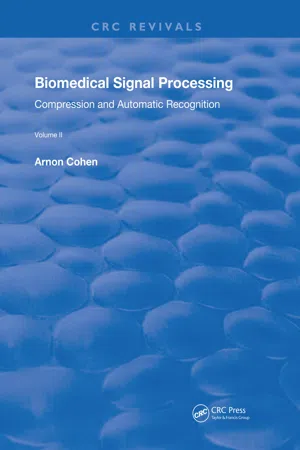
- 196 pages
- English
- ePUB (mobile friendly)
- Available on iOS & Android
eBook - ePub
About this book
First published in 1986: The presentation of the material in the book follows the flow of events of the general signal processing system. After the signal has been acquired, some manipulations are applied in order to enhance the relevant information present in the signal. Simple, Optimal, and adaptive filtering are examples of such manipulations. The detection of wavelets is of importance in biomedical signals; they can be detected from the enhanced signal by several methods. The signal very often contains redundancies. When effective storing, transmission, or automatic classification are required, these redundancies have to be extracted.
Frequently asked questions
Yes, you can cancel anytime from the Subscription tab in your account settings on the Perlego website. Your subscription will stay active until the end of your current billing period. Learn how to cancel your subscription.
At the moment all of our mobile-responsive ePub books are available to download via the app. Most of our PDFs are also available to download and we're working on making the final remaining ones downloadable now. Learn more here.
Perlego offers two plans: Essential and Complete
- Essential is ideal for learners and professionals who enjoy exploring a wide range of subjects. Access the Essential Library with 800,000+ trusted titles and best-sellers across business, personal growth, and the humanities. Includes unlimited reading time and Standard Read Aloud voice.
- Complete: Perfect for advanced learners and researchers needing full, unrestricted access. Unlock 1.4M+ books across hundreds of subjects, including academic and specialized titles. The Complete Plan also includes advanced features like Premium Read Aloud and Research Assistant.
We are an online textbook subscription service, where you can get access to an entire online library for less than the price of a single book per month. With over 1 million books across 1000+ topics, we’ve got you covered! Learn more here.
Look out for the read-aloud symbol on your next book to see if you can listen to it. The read-aloud tool reads text aloud for you, highlighting the text as it is being read. You can pause it, speed it up and slow it down. Learn more here.
Yes! You can use the Perlego app on both iOS or Android devices to read anytime, anywhere — even offline. Perfect for commutes or when you’re on the go.
Please note we cannot support devices running on iOS 13 and Android 7 or earlier. Learn more about using the app.
Please note we cannot support devices running on iOS 13 and Android 7 or earlier. Learn more about using the app.
Yes, you can access Biomedical Signal Processing by Arnon Cohen in PDF and/or ePUB format, as well as other popular books in Biological Sciences & Biology. We have over one million books available in our catalogue for you to explore.
Information
Chapter 1
WAVELET DETECTION
I. INTRODUCTION
A common problem in biomedical signal processing is that of detecting the presence of a wavelet in a noisy signal. A wavelet is considered here as any real valued function of time, possessing some structure. The approximate shape of the wavelet, expected to be present in the noisy signal, may be known and the requirements are to estimate its time of occurrence and its exact shape. The problem, of course, is not restricted to biomedical signals; it appears, for example, in communications, radar, sonar, or seismological signals. Two main approaches are used to solve the problem. The first uses structural features of the wavelet and the second uses template matching techniques.
The approximate knowledge of the wavelet’s shape can be used to select typical structural features. These features are random variables with some empirically determined probability density functions. The noisy signal is then continuously searched for these features.
The search can be conducted in various ways. Sophisticated algorithms that can be used to recognize a wavelet, once its features have been extracted, are discussed in Chapters 3 and 4. These algorithms are based on the decision-theoretic or syntactic approaches to pattern recognition. In this chapter we shall consider much simpler techniques, which are usually implemented by relatively inexpensive, dedicated hardware. The algorithms are primarily heuristic and are usually specific to a given wavelet (say the QRS complex in the ECG).
A more general approach is the one where the approximate knowledge on the wavelet is used to generate a template, which is some average wavelet determined by the a priori knowledge on the signal. The signal is then continuously matched with the template by means of correlation, matched filtering, or other pattern recognition techniques. The method is general in the sense that one can use the same algorithm for the detection of any wavelet by just replacing the template. The choice bet...
Table of contents
- Cover
- Title Page
- Copyright Page
- Dedication
- Preface
- The Author
- Table of Contents
- Chapter 1 Wavelet Detection
- Chapter 2 Point Processes
- Chapter 3 Signal Classification and Recognition
- Chapter 4 Syntactic Methods
- Appendix A Characteristics of Some Dynamic Biomedical Signals
- Appendix B Data and Lag Windows
- Appendix C Computer Programs
- Index